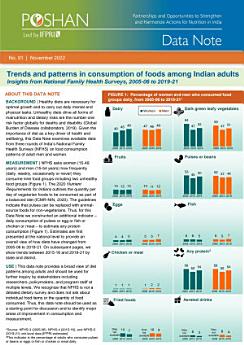Trends and patterns in consumption of foods among Indian adults: Insights from National Family Health Surveys, 2005-06 to 2019- 21
About this ebook
MEASUREMENT| NFHS asks women (15-49 years) and men (15-54 years) how frequently (daily, weekly, occasionally or never) they consume nine food groups including two unhealthy food groups (Figure 1). The 2020 Nutrient Requirements for Indians outlines the quantity per day of vegetarian foods to be consumed as part of a balanced diet (ICMR-NIN, 2020). The guidelines indicate that pulses can be replaced with animal-source foods for non-vegetarians. Thus, for this Data Note we constructed an additional indicator –daily consumption of pulses or egg or fish or chicken or meat –to estimate any protein consumption (Figure 1). Estimates are first presented at the national level to provide an overall view of how diets have changed from 2005-06 to 2019-21. On subsequent pages, we show trends between 2015-16 and 2019-21 by state and district.
USE| This data note provides a broad view of diet patterns among adults and should be used for further inquiry by stakeholders including researchers, policymakers, and program staff at multiple levels. We recognize that NFHS is not a detailed dietary survey and does not ask about individual food items or the quantity of food consumed. Thus, this data note should be used as a starting point for discussion and to identify major areas of improvement in consumption and measurement.











